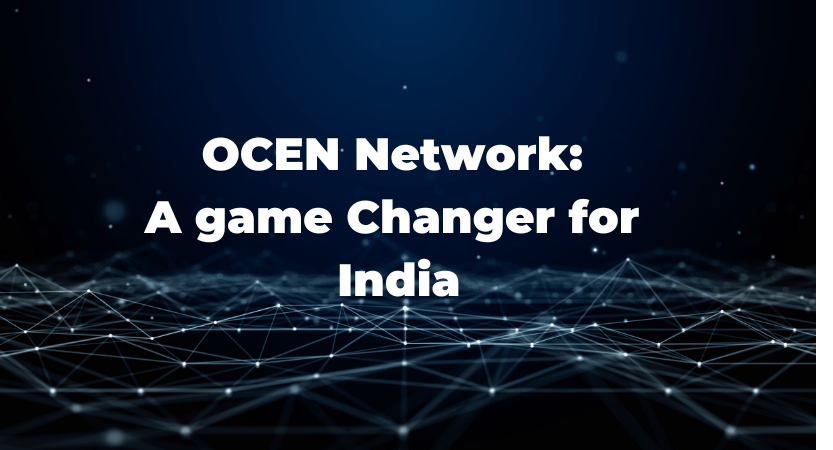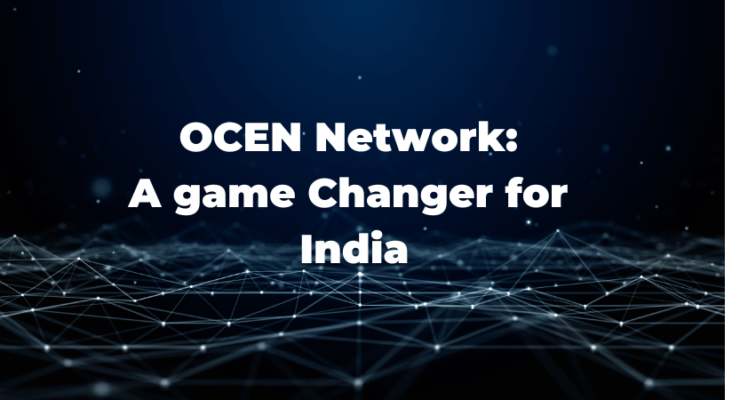OCEN: Revolutionizing India’s Credit Landscape through Open Credit Enablement Network
Introduction:
The Open Credit Enablement Network (OCEN) is a groundbreaking digital public good (DPG) that has the potential to transform and democratise India’s digital lending landscape. Developed by iSPIRT, an Indian software industry think tank, OCEN is designed as a framework of Application Programming Interfaces (APIs) that can be integrated with various digital platforms and apps. Its primary objective is to empower individuals and micro, small, and medium enterprises (MSMEs) by providing them with direct access to financial products, thereby reducing their reliance on traditional lenders. The vision behind OCEN is to create a credit marketplace and a comprehensive digital ecosystem of lenders and loan service providers (LSPs).
India has already established itself as a leader in developing digital public infrastructure and goods that address development challenges on a large scale. Examples include Aadhaar, which provides a foundational identity to Indians. The Unified Payments Interface (UPI) has accelerated financial inclusion, and the CoWIN platform played a vital role in India’s COVID-19 vaccination program. Aadhaar enrollment has reached 1.33 billion, with over 73.5 billion Aadhaar-based transactions recorded as of April 2022. With around 400 million users in India, the UPI has facilitated 6.5 billion transactions worth INR 10.72 trillion and is now being adopted in other countries.
OCEN, being developed by iSPIRT, aims to achieve a similar scale of adoption and revolutionise the credit value chain while boosting the digital economy. As a DPG in development, OCEN aligns with the nine defining elements of DPGs, including platform independence and data privacy and security.
The Need for Formalising the Credit System and the Role of Technology:
The limitations of traditional lenders in expanding their reach have resulted in a credit gap of approximately US $380 billion in the Indian MSME sector. Even the credit card industry has struggled to penetrate the vast Indian market. Currently, only 3 per cent of the population in India possesses a formal credit card, primarily concentrated in tier 1 cities.
Acquiring a loan involves multiple responsibilities for LSPs, including sourcing, identity verification, underwriting, disbursement, recollections, and dispute management. Each of these processes is time-consuming and impacts the profitability of LSPs. Moving these processes online would reduce the time and cost of loan disbursements, leading to more favourable interest rates for borrowers.
How OCEN Can Make a Difference
· OCEN introduces a new technology that automates and streamlines lending processes. It bundles various lending processes and executes them online. It incorporates screening processes to identify creditworthy customers and facilitates onboarding new borrowers. Integrating the verification process with Aadhaar’s eKYC system further streamlines these processes. In September 2022, 25.25 crore eKYC transactions were conducted through the platform, bringing the total number of transactions to 1,297.93 crore.
· By digitising credit systems, OCEN aims to democratise access to credit by connecting loan providers with individuals not part of the formal credit system. Non-bank small-scale lenders can utilise expanding the scope of lending and borrowing opportunities.
For example,
The iSPIRT website showcases a list of lenders available to customers. The OCEN API can be integrated with e-commerce websites, digital marketplaces, and other apps to facilitate loan acquisition during a purchase.
· Expanding borrowing options beyond traditional assets and incomes has been a significant challenge for the growth of traditional lending. OCEN addresses this challenge by enabling wider technology adoption in the marketplace, providing borrowers with more diverse and personalised options.
Potential Impact and Future Prospects:
The implementation of OCEN could significantly impact India’s financial ecosystem. By unlocking credit access for MSMEs, the engine of India’s economic growth, OCEN can boost their productivity and competitiveness. The estimated credit gap of $380 billion in the MSME sector can be effectively filled by leveraging the power of digital platforms and OCEN’s standardisation.
Moreover, OCEN can encourage the creation of specialised origination and tailored credit products, such as microloans for specific sectors or communities. This opens up new revenue streams for lenders while enabling borrowers to access credit products that cater to their unique needs.
Challenges and the Way Forward:
While OCEN offers immense potential, several challenges need to be addressed. These include ensuring responsible lending practices, managing loan defaults, promoting transparency and accountability in loan-related data, and safeguarding cybersecurity and data protection. Implementing dispute resolution mechanisms, digital ombudspersons, and robust data privacy regulations are crucial to building trust and confidence in the system.
Conclusion:
As a groundbreaking digital public good, OCEN has the potential to revolutionise India’s credit landscape and drive financial inclusion. By providing a standardised credit protocol infrastructure, OCEN empowers individuals and MSMEs, enables non-bank lenders, and expands the lending ecosystem. With technology integration, OCEN can bridge the credit gap, catalyse economic growth, and foster a more inclusive financial system. As India continues to develop its digital infrastructure, OCEN has the potential to become another success story and a beacon for other countries aiming to enhance financial inclusion through digital lending.
Top of Form




